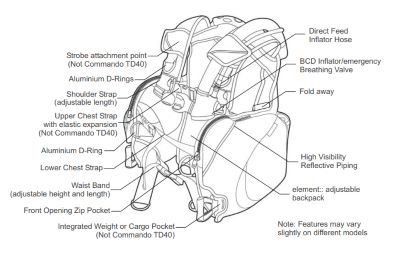Home › Diving Info › Scuba Equipment › BCD › Maintenance
BCD Care and Maintenance Tips
Some divers fail to understand exactly how a buoyancy compensator (BC) works and how to repair, or replace, the different components, such as the inflator button.
Follow these pre dive and post dive buoyancy control device maintenance tips to keep your BCD in tip top condition and extend its reliability and lifespan.
How Do Buoyancy Compensators (BC) Work
Having an inflation device to help you achieve neutral buoyancy makes scuba diving much more relaxing.
Simply put, a BCD reduces the need for excessive energy and it helps you to hover 'weightless' while you're underwater.
This means you can drift along with the flow of the column mid-water.
Here's the thing:
Apart from giving you a lot of control in the water, you can also use it to float in a comfortable position at the surface.
After attaching a BCD to a scuba cylinder, effective and efficient buoyancy will depend on how well it fits your body shape. In addition, you will also need to use some kind of diving weights and trimming for extra fine-tuning.
Pro Tip: Depressing the auto-inflate button allows air to flow from the dive tank into the jacket. But, you can also inflate a BC 'orally' by blowing air into the mouthpiece opening while depressing the inflator button.
List of BCD Components
- BCD air bladder system (expandable) that usually combines Cordura® 1000 Deniers (on the outside) with 500 Deniers (on the inside)
- Power inflator (low pressure) and oral inflation (manual mechanism) with Velcro® tabs
- Deflator mechanism (manual) and overpressure dump valves (usually located at shoulder level and bottom right corner of the jacket)
- Pressure release valve mechanism (automatic)
- Backplate with nylon belt tank band and interlocking buckle
- Pockets (for storing cool scuba stuff) and D-rings, clips, and hose connectors (for easy attachment of accessories)
- Pockets for integrated weight system (to avoid wearing a weight belt)
- Alternate inflator regulator (on some models) which combines the alternate air source with the low-pressure inflator
Different Styles of BCD
- Jacket style buoyancy control devices are the most popular in recreational scuba diving (with different styles and colours available for female divers and children).
- Wing style BCD (back-mount)
- Travel BCDs (usually made with lightweight materials)
- Technical diving systems (combining a harness setup with a wing-style bladder)
- Sidemount scuba systems (using a back wing and harness system with tanks mounted on the sides).
BCD Pre Dive Checks
Inspect the BC for signs of corrosion or damage to valves, hoses, or buckles. Attach the low pressure inflator hose from the regulator and inflate the jacket using air from the dive tank.
After fully filling the BCD with air, check that the pressure-release valves (dump valves) open. Leave it inflated for at least ten (10) minutes to check for air leaks.
 The jacket should hold its air pressure without leaking. Have a scuba technician repair any leaks before using it in water.
The jacket should hold its air pressure without leaking. Have a scuba technician repair any leaks before using it in water.
While you are conducting the air leak test, you can also:
- Check the plastic and metal buckles for corrosion and proper function.
- Inspect the cummerbund (plus extender), tank band, shoulder straps, and waist strap for excessive wear.
Note: Typical signs of corrosion are rusty-brown colouring, white chalkiness, or green powder residue.
Remove minor rust stains with white vinegar or a soft wire brush. Rinse thoroughly with fresh water afterwards, and regularly apply a silicone spray to help reduce further corrosion.
Before you go diving, ensure the corrugated hose dump and remote exhaust valve cords work properly. You can test them by gently pulling the hose away from the jacket and yanking on the valve toggle cords.
BCD Postdive Care and Maintenance
After diving, replace the rubber cap to protect the power inflater connection (if applicable). Thoroughly hose down or soak the BCD with freshwater for at least five (5) minutes to remove sand, salt, chlorine residue, or dirt - both inside and outside.
The next step is one of the most important - yet often neglected. Fill the BCD internal bladder about half full with fresh water. Depress the oral-inflator button and gently run water into the plastic mouthpiece.
Shake the jacket to create a sloshing and agitating of water around the internal bladder. This helps to remove salt water or chlorine from the bladder skin.
Key takeaways:
Following a thorough rinsing, you will need to drain the water. Tip the BCD upside down while opening the manual inflator button. You should also open the exhaust dump valves to allow water to flush through those assemblies.
Manually inflate the bladder by blowing into the power hose (e.g. the oral mechanism0. Partially inflating the BCD allows you to check the corrugated hose and valve caps for signs of wear.
Your buoyancy controller may have an integrated weight system with ballast pouches. If so, be sure to check the proper function of the quick-release buckles after cleaning.
Inflate the BCD to about half full and hang it in a shaded area out of direct sunlight. Check for leaks one more time before storing it in a cool, dry, area ready for the next time you go diving.
Pro Tip: Apart from smoking and diving, one of the other scuba bad habits to avoid is leaving solid diving weights in BCD pockets during storage.
Related Information and Help Guides
- Best BCD: What Makes a Good Buoyancy Controller?
- Scuba BCD Setup Explained for complete Beginners
- Why Do Some Divers Prefer to Dive with a Wing BCD?
Note: The short video tutorial [1:01 seconds] presented by PADI® shows how to set up a BCD on a dive cylinder and finish the gear assembly in preparation for pool training or a scuba dive.